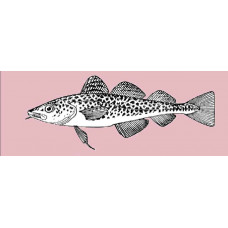Latin name
Gadus morhua
Other names
Cod, codfish, codling, scrod; French: morue de l’Atlantique; German: dorsch, kabeljau; Italian: merluzzo bianco; Japanese: madara, tara; Norwegian: torsk; Portuguese: bacalhau; Spanish: bacalao del Atlántique.
Identification
The Atlantic cod has three dark dorsal fins and two dark anal fins, none of which have spines. The body is heavy and conical, with a prominent chin slant, a large mouth, and many small teeth. The muzzle is rounded at the top, and the tail is almost square. There is a characteristic pale lateral line. The coloration is very variable on the back and sides. It can range from brownish or sandy to gray, yellow, reddish, greenish, or any combination of these colors, grayish-white on the underside, with numerous light spots covering the body.
Distribution
The cod's extensive range covers the northern part of the Atlantic Ocean and adjacent waters of the Arctic Ocean. Along the shores of Europe, the species inhabits from the Bay of Biscay in the west to the Kara Gate Strait in the east. The northwestern tip of Spitsbergen and the Perseus Highlands serve as the northernmost boundary of the range. In warm years, the cod occasionally makes its way to the southwestern part of the Kara Sea. Occurs in the Baltic Sea, and less frequently in the White Sea. Numerous in the North Sea, around the islands of Great Britain, the Faroe Islands and Iceland, as well as off the southeast and southwest coasts of Greenland. Cod is sometimes found off Jan Mayen Island. On the coast of North America, the fish inhabits from Cape Hatteras in the south to the Hudson and Davis Straits in the north.
Habitat
These fish are predominantly found off the coast along the continental shelf. They prefer cool water of 30° to 50 °F and can live in depths of up to 200 fathoms. Adults usually live in depths of more than 60 feet; juveniles can be found in shallower water. In summer, all move to deeper water.
Size
Cod can live up to 25 years and more. The lifespan of cod living along the southern edge of the range is shorter than that of cod living in the north. The highest linear growth rate is found in cod around the UK islands and in the North Sea. The ratio of males to females at different developmental stages is about the same (1:1). Young fish between 2 and 5 years of age weigh between 4 and 15 pounds. Some reach a length of 30 to 40 inches. It has been known to reach 211 pounds. The record weight of cod is 98 pounds 12 ounces.
Life history and Behavior
The spawning season is in December and January in the Mid-Atlantic Gulf and February through April in the north.
Food and feeding habits
The first food of larvae is crustaceans, eggs, bivalve mollusk larvae, and phytoplankton. The food selectivity of larvae is dimensional rather than species-specific. Sometimes herring and sea bass fry are found in the stomachs of pelagic cod fry. In September-October cod fry, like plankton, make daily vertical migrations, feeding on benthic juveniles, fish fry, polychaete worms, etc. The main food items of cod are small fish (capelin, herring, sand lance), juveniles of various fish, including cod, haddock, flounder, as well as crabs, shrimp, bivalve and gastropod mollusks, worms, other pelagic and benthic organisms. Large cod often lead a solitary predator lifestyle.
Reproduction
The breeding sites of different herds are isolated from each other, but there is no complete isolation. Maximum fecundity reaches 15-20 million eggs in individuals aged 13-18-20 years. Cod at age 10 has a fecundity of about 5 million eggs, an 8-year-old has less than 3 million eggs. Spawning occurs in March-April in the water column or near the bottom during the day or in the evening in the intermediate layer at a water temperature of 4-6 °C. In the waters of Iceland, the North Sea, the waters off the Faroe Islands cod spawning in February and March at a depth of 30-100 m in water temperature 5-7 °C, in the Northwest Atlantic at a depth of 100-200 m in water temperature 3-6 °C. The spawning period is protracted and is 1.5-2 months for females. Males stay on spawning grounds longer than females. Females spawn at least 8 eggs. The number of eggs in a batch and their diameter decrease with each batch. During the spawning period, males numerically outnumber females.
| Classification | |
| Phylum | Chordata |
| Class | Actinopterygii |
| Squad | Gadiformes |
| Family | Gadidae |
| Genus | Gadus |
| Species | G.morhua |
| Features | |
| Conservation status | Vulnerable |
| Habitat | Littoral |
| Life span, years | 25 |
| Maximum body weight, kg | 50 |
| Maximum length, cm | 180 |
| Sailing speed, m/s | No information |
| Threat to people | Edible |
| Way of eating | Bentophage |




